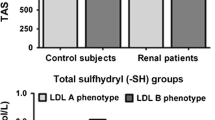Abstract
Oxidative stress is enhanced in patients with end-stage renal disease (ESRD) undergoing hemodialysis (HD). Bioincompatibility represents an important source of reactive oxygen species. HD patients exhibit altered antioxidative defenses, and antioxidative vitamins such as vitamin E and C are altered in uremia. Frequently, HD patients also suffer from atherosclerotic cardiac disease. We previously reported that low-density lipoprotein (LDL) of HD patients is rich in malondialdehyde (MDA), an end product of lipid peroxidation. MDA-rich LDL is thought to be an atherogenic lipoprotein because of its enhancement of macrophage foam-cell formation. We conducted a controlled study for 2 years comparing the effects of a vitamin E-coated cellulose membrane dialyzer and an ordinary cellulose membrane dialyzer on lipid metabolism and the progress of atherosclerosis. LDL MDA and oxidized LDL (ox-LDL) were measured in HD patients by using these two types of dialyzers. Plasma vitamin E and lipid concentrations were also evaluated. Aortic calcification index (ACI) was evaluated by CT scan to assess the progress of atherosclerosis before and every year after initiation of the treatment. The use of a vitamin E-coated cellulose membrane dialyzer for 6 months, 1 year, and 2 years resulted in a significant reduction in LDL-MDA and ox-LDL compared with that obtainal with the use of the ordinary cellulose membrane dialyzer. The treatment with a vitamin E-coated dialyzer significantly reduced the percent increase in ACI after 24 months as compared with control. There were no significant differences in plasma vitamin E and lipid concentrations between the two groups. These results suggest that oxidative stress could be one of the factors stimulating abnormal lipid metabolism and atherosclerosis in ESRD patients.
Similar content being viewed by others
References
Lindner A, Charra B, Sherrard DJ, Scribner BH. Accelerated atherosclerosis in prolonged maintenance hemodialysis. N Engl J Med 1974;290:697–701
Bonomini V, Feletti C, Scolari MP, Stefoni S, Vangelista A. Atherosclerosis in uremia: a longitudinal study. Am J Clin Nutr 1980;33:1493–1500
Brown MS, Goldstein JL. Lipoprotein metabolism in macrophages. Annu Rev Biochem 1983;52:223–261
Yukawa S, Hibino A, Maeda T, Mimura K, Yukawa A, Maeda A, Kishino M, Sonobe M, Mune M, Yamada Y, Niside I. Effect of α-tocopherol on in vitro and in vivo metabolism of low-density lipoproteins in haemodialysis patients. Nephrol Dial Transplant 1995;10(Suppl 3):1–3
Jackson P, Loughrey CM, Lightbody JH, McNamee PT, Young IS. Effect of hemodialysis on total antioxidant capacity and serum antioxidants in patients with chronic renal failure. Clin Chem 1995;41:1135–1138
Maggi E, Bellazzi R, Falaschi F, Frattoni A, Perani G, Finardi G, Gazo A, Nai M, Romanini D, Bellomo G. Enhanced LDL oxidation in uremic patients: an additional mechanism for accelerated atherosclerosis? Kidney Int 1994;45:876–883
Saccini C, Jialal I. LDL modification by activated polymorphonuclear leukocytes: a cellular model of mild oxidative stress. Free Radical Biol Med 1994;16:49–55
Berliner JA, Territo MC, Sevanian A, Ramin S, Kim JA, Bamshad B, Esterson M, Fogelman AM. Minimally modified low-density lipoprotein stimulates monocyte endothelial interactions. J Clin Invest 1990;85:1260–1266
Klouche M, Gottschling S, Gerl V, Hell W, Husmann M, Dorweiler B, Messner M, Bhakdi S. Atherogenic properties of enzymatically degraded LDL: selective induction of MCP-1 and cytotoxic effects on human macrophages. Arterioscler Thromb Vasc Biol 1988;18:1376–1385
Yukawa S, Sonobe M, Tone Y, Yukawa A, Mimura K, Mune M, Maeda T, Nomoto H, Nishide I. Prevention of aortic calcification in patients on hemodialysis by long-term administration of vitamin E. J Nutr Sci Vitaminol 1992 (Special number): 187–190
Saruhashi M, Watanabe H, Sasaki M. Biocompatibility of vitamin E-modified regenerated cellulose. Jpn J Artif Organs 1995;24:631–636
Galli F, Rovidati S, Chiarantini L, Campus G, Canestrari F, Buoncristiani U. Bioreactivity and biocompatibility of a vitamin E-modified multi-layer hemodialysis filter. Kidney Int 1998;54:580–589
Itabe H, Takeshima E, Iwasaki H, Kimura J, Yoshida Y, Imanaka T, Takano T. A monoclonal antibody against oxidized lipoprotein recognizes foam cells in atherosclerotic lesions. J Biol Chem 1994;269:15274–15279
Author information
Authors and Affiliations
Rights and permissions
About this article
Cite this article
Mune, M., Otani, H. Abnormal lipid metabolism and oxidative stress in hemodialysis patients. J Artif Organs 4, 19–22 (2001). https://doi.org/10.1007/BF01235829
Received:
Issue Date:
DOI: https://doi.org/10.1007/BF01235829




